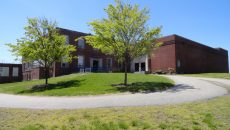UMass Lowell’s recent purchase of Perkins Park Complex right next to the Tsongas Center which places about 700 students right next to the Tsongas Center, where many of UMass Lowell’s games take place, in particular ice hockey and basketball. UMass Lowell’s NCAA Division I ice hockey team is known to draw large crowds, and that is partially due to the Tsongas Center itself.
With better accommodations for the patrons such as accessible parking, shuttles and a variety of concessions, it is a no-brainer why this venue that hosts all Division I games. And as UMass Lowell’s basketball team makes the transition from Division II to Division I, the Basketball games are also making the transition from playing at the Costello Athletic Center to the Tsongas Center.
In 2013, UMass Lowell’s basketball team began the transition to Division I, and as per their agreement, they began a four-year process of slowly transitioning the games from the Costello Center to the Tsongas. This is due to the fact that the Tsongas Center is a venue that is able to hold Division I sports in due to its accessibility, larger size and the technology implemented into the building, such as the huge four-by-four screen in the middle of the arena. By the next academic year, the basketball team will play their games full-time at the Tsongas Center. However, what does this mean financially for UMass Lowell?
Hosting the games at the Tsongas Center does cost significantly more, but currently UMass Lowell does not know how much it will cost for a full year’s worth of games. Right now, UMass Lowell Athletic Department is working with the Tsongas Center Management Team in order to determine just that.
They are conducting a study to determine not only the financial impact, as well as the availability of the Tsongas in terms of the various concerts and events that are held there.
“We’re looking at this for next year right now,” said Dana Skinner, the director of athletics, “in terms of moving all the games over here [Tsongas Arena].”
UMass Lowell still has not made the complete transition over to the Tsongas, so the full costs are still unknown at this time as they work to examine the exact costs, including the cost of converting the ice rink to a basketball court, as it’s done for concerts and other events held at the Tsongas. “Generally speaking it costs about $3,000 a night to turn the facility from an ice rink to a basketball court and back again,” Skinner said, adding that is what the general set up costs are per night, and factoring in the 20-23 home games UMass Lowell hosts each season for men’s and women’s basketball.
In terms of sales and revenue that the games make, Skinner said, “We’re working different revenue stream right now, adding to our existing revenue packages,” giving the examples of selling corporate sponsorships, internet advertisements, and even radio advertisements. This includes the newly announced package with ESPN3, where all of UMass Lowell’s games will be hosted online.
With this transition, UMass Lowell’s athletics hopes to replicate the popularity of the ice hockey team by taking a similar advertising strategy when promoting these newly held games. With the permanent transfer to the Tsongas happening the next academic year, they hope the attendance will increase as it did with ice hockey, Skinner said. He said the basketball games hosted at the Costello Center usually draws in a crowd of 300 to 400 people, while the Tsongas Center has never had a crowd less than 1,200 at their basketball games (while the ice hockey games usually see an average crowd of 5,000). Skinner remarks that the biggest challenge is getting fans to come down and attend the games in person.
“The fans in my generation grew up attending sporting events,” Skinner said. “The fans in your generation grew up watching everything on their iPads and their iPhones.”
There has been a notable trend with the technology age, giving people less incentive to attend games when they could potentially watch it from the comfort of their home. Skinner, as well as UMass Lowell as a whole, hopes that the switch over the Tsongas Center, with its improved facilities along with the incredible basketball team will attract more attention from fans, and allow them to become more attached and invested in not only just the team, but UMass Lowell overall.
With the basketball team making their final transfer to the Tsongas Arena in the next academic year, the total costs of this move still remain unknown. But with the purchase of Perkins Park complex, as well as the implementation of advertising strategies, improved facilities and concessions, the basketball games are sure to draw in larger crowds and increased amounts of revenue.



